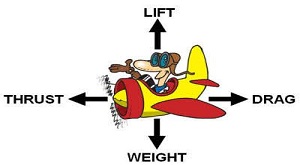
They have asked me many times throughout the years how a big airplane can fly Have you ever wondered, Is Aerodynamics Important In Flight?
Is Aerodynamics Important In Flight?
Aerodynamics is the most important lesson in the Private Pilot syllabus and in learning to fly. It teaches the reasons an airplane can fly. Understanding aerodynamics will save your life.
Is Aerodynamics Important In Flight?
1. A Hard Lesson In Aerodynamics.
Single pilot IFR is not an easy ride sometimes.
Maybe it’s a fear of dying alone or just needing the reassuring voice of another pilot aboard. But I flew a lot of single-pilot IFR.
I found myself glad that I had practiced stalls and spins until I loved doing them one winter morning in Scottsbluff, Nebraska. A low-time 1700-hour Freight Dog on my daily Denver run.
Ice had encumbered the PA31-350 Piper Navajo I was flying until it barely hung in the sky, and it petrified me it would stop flying at any second. One second of panic would have killed me.
I was far too busy to be afraid and I guarantee it entirely focused my attention on flying.
The wings would stall if I did not maintain high throttle settings, and the tail would stall if I attempted to climb very fast. I had to make extremely shallow cuts in turns because of possible wing stalls. And I was flying a missed approach.
An alternate airport was not an option.
The point is that many pilots would have never recognized when the wing stalled, or the tail stalled.
I had spent hours studying aerodynamics and stalls and I had flown in Ice, but not this much Ice.
Because of my training in aerodynamics and experience, even with low time (1600 hours), I could save my life, the airplane, and freight. I learned to understand aerodynamics is very important in flight. It is an important part of flight training.
I was very fortunate to have lived through that flight. It was one of the many close calls that came along during my career.
I will write this story in a later post.
2. Four Forces Of Flight. What Makes A Plane Fly?
Four items act upon any object in flight and they are lift, weight, thrust, and drag. These make aerodynamics important in flight.
Airflow over and under the wing creates lift.
Since the wing is cambered the top of the wing has a larger surface area than the nearly flat bottom of the wing. This creates a low-pressure area beneath the wing, pushing the aircraft airborne. (Bernoulli’s Principle). Thus we have “lift.”
The opposing force to lift is gravity or weight and that makes sense as the heavier the airplane, the harder the wing has to work. So we must beat gravity into submission to fly.
Thrust comes from the engine-driven propeller and must oppose drag, which comprises the force of the wind against the aircraft, the weight of the aircraft, etc. Check out the NASA page on aerodynamics. It doesn’t have much more to say than is presented here. See it here.
3. So What Is Aerodynamics?
Aerodynamics is the study of the motion of air when affected by a solid object like the wing of an aircraft.
With a wing, anything that disrupts the even flow of air over and under the wing is a dangerous issue. Ice is by far the most dangerous.
Studying aerodynamics in relation to flying is a necessity. This will help any pilot understand the number of G forces that are present on the aircraft. An example is the load on the aircraft in a 60-degree level flight turn is 2 G’s.
I always paid close attention to the way the aircraft felt in maneuvers, and it was pretty hard not to. I don’t imagine there are many that don’t remember the feel of a full stall in an airplane. Flying “by the seat of your pants” is still the way to fly an airplane.
The time spent learning about aerodynamics is very well spent.
The question “Is Aerodynamics Important In Flight,” should be a statement, “Aerodynamics is Very important in flight!”
Final Thoughts.
I am grateful that I had an experience with stalls, spins, and tail stalls.
My knowledge of Aerodynamics needs to be refreshed now and again. I can say that whenever I look at even Private Pilot test questions, it taxes my memory. I took a quiz on aerodynamics recently and only scored 66% which did not surprise me because I have forgotten a lot of information that is critical to safe flying.
It’s important at least for me to be responsible for all the certificates and ratings I have. That means staying informed with new readings and older previously studied material.
They test airline pilots more than any other profession and I feel it’s a necessary evil. We should hold other professions that are responsible for people to those standards since they hold people’s lives in their hands, just as pilots do.
Take some time occasionally to review your knowledge base and attempt to improve upon it. That will make you a better pilot.
Learn your aircraft from flying it and studying the locations of fuses in the event of an emergency.
I just heard of a pilot who died at his home airport because he panicked over a runaway trim. Had he likely not panicked and known where to pull that breaker, he would be alive. Don’t be a statistic.
Fly safe and please leave a comment, a question, or criticism.
